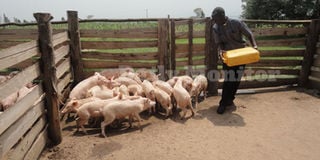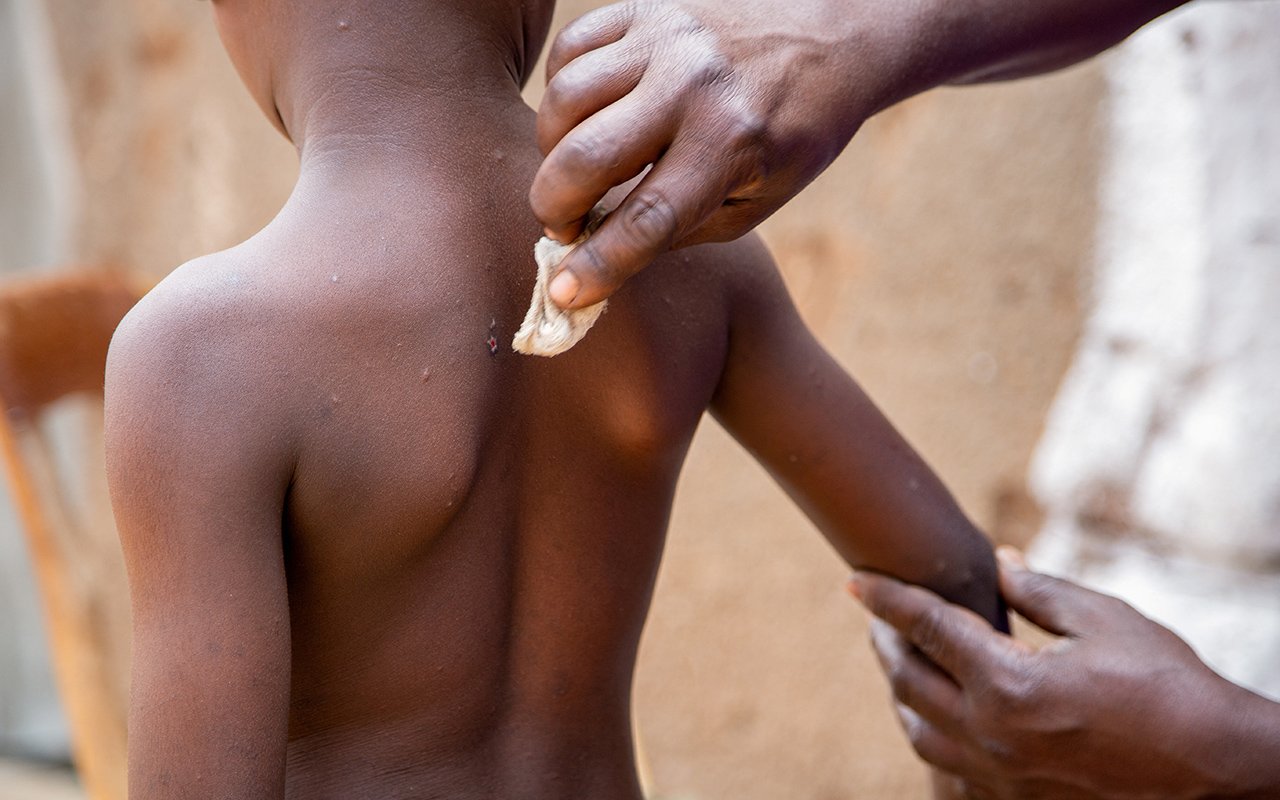Prime
IMO: An innovative way to practise piggery

Rev Musiime feeds the pigs that are being kept under the IMO system. PHOTOS BY Otushabire Tibyangye
Piggery is a lucrative venture but also demands good farming practices for better results. There is a notion that pigs are dirty animals but on the contrary, if well looked after, they are one of the cleanest farm animals since they do not sleep where their droppings are and defecate in a particular place.
Most farmers keep pigs in a confined house but others use the free range system. It is important to note that the initial costs of housing and feeding are very high yet they determine the outcome of the investment.
Feeding alone accounts for 60- 70 per cent of the total investment. The commercial feeding of pigs is relatively expensive and eats often into the profits of a farmer.
Three types of feeds are available with differing protein content. A pig on average eats two to three kilos a day. The feeds should include all nutritional requirements. The diet should include maize bran, fish meal, cassava, cotton-seed cake, pre-mixed vitamins and water.
Improve housing and feeding
However, an innovative method to improve on the housing and feeding method using indigenous micro-organisms (IMO) can also be used to improve piggery.
Dr Charles Lagu, the zonal Naads coordinator Mbarara, says the programme is jointly funded by Naads and Korea International Cooperation Agency (KOICA). This is set to benefit pig farmers through better animal health and reduction of feeding costs.
Benefits of this technology include elimination of odours, prevention of pollution and enhancement of IMO in the soil.
It eliminates the need for artificial heating as heat is concentrated by translucent corrugated sheet used in roofing and retained saw-dust.
The micro-organisms used have the capacity to hydrolyse cellulose in saw-dust to edible sugars. Thus, the sawdust also acts as feed.
Reduction of feed costs: It requires that only 70 per cent of the pig’s food requirements to be provided as supplements. The rest of the portion will come from the saw dust. It also does not require the use of water in the feeding.
“It is these very attributes that are being promoted in this technology and are very relevant to farmers especially in the economic hardships that the country is experiencing”, Lagu says.
Rev Polly Musiime, 68, of Katojo Village, Bubaare Sub County in Mbarara District, is one of the implementing farmers. He started rearing pigs under this programme and has found it very beneficial to a farmer.
He started with 10 parent stock animals and has expanded his piggery to 130. The target is 500.
Tapping the organisms
The following materials are needed in tapping the IMO carbohydrate foods e.g. rice, sweet potato, Irish potatoes, a medium-sized bucket , small net similar to a mosquito net and a container with a 100-litre capacity.
Boil 20kg of the available carbohydrate foods (rice, banana, cassava, sweet potato or Irish potato). Cook with crude salt (200g) until ready.
Mash the food into a fine paste and after cooling make small balls the size of a tennis ball.
Tie the small balls in the net and bury in the ground in a shaded area about two inches deep, preferably under trees to protect them from direct sunlight. Keep the mixture buried for four to five days.
After these days, check to see whether the moist carbohydrate is covered with white mould. If mould growth is sparse, cover the mixture again and wait an additional two to three days before checking again.
If the mould is a colour other than white (other colours indicate growth of less effective fungi) or if rain has entered the box, the contents should be discarded and the process repeated.
The process of making cultures of the indigenous microorganisms is a critical component of the natural pig rearing technology and without it one cannot realize the benefits it is intended to provide.
Multiplication of the culture
For every 2kg of the mixture, add 500g of brown sugar and mix well.
Put the resulting mixture in a plastic bucket and cover securely with a net and leave to stand in a secure place for five to seven days at between 20 and 22 degrees Celsius.
After this time the mixture will have changed colour to black but with no smell.
Dilute the IMO culture to suit the farmer’s needs The following guidelines are provided on the dilution of the IMO culture to usable concentrations.
Add 5 per cent by weight of maize meal or maize bran into the IMO mixture you have prepared and mix well.
Make a solution of 1:200 parts that is 1kg of IMO culture to 200 litres of water and keep for two days. You may add some brown sugar to make the multiplication process quick.
After 2 days the solution is ready for use. 200 litres of IMO solution may last for 10 days.
Using the IMO in feeds
The liquid IMO culture is applied to saw-dust while the pigs are being fed with the usual food. The micro organisms then digest the cellulose in saw dust and the pigs start eating the saw dust.
“The pigs’ excrement is so odourless, clean and dry, that you literally don’t even have to clean it out. As the organisms continue to digest the cellulose in saw dust, the quantity will require to be replenished as the pigs eat a most of the litter”, Lagu says.
The inputs are made from natural materials, which are not only safe for the environment, but actually invigorate and rehabilitate the ecology.
Disease control: The conditions inside the house where pigs are reared naturally do not favour survival of disease causing pathogens. Also due to confinement, disease is rare in pigs reared as such.
Production of organic fertiliser: Ultimately, the decomposed litter will be removed from the pig sty and used as manure. This manure is rich in IMO and is more useful in improving the health of soil than chemical fertilisers.
Rev Musiime attests that since he started his piggery he has not spent money on treating the animals because IMO has been very effective.
“My animals have never fallen sick and they do not give out the offensive smell since the excreta dries up easily,” he says.
Modifying the house.
The traditional piggery usually consists of paved floors and walls of either bricks, wooden or mud and wattle but this has been modified to contain translucent sheets on the rooftops and unequal roof.
The use of a translucent corrugated sheet on the roof to concentrate the sunrays and produce heat in the litter inside the pigsty.
Unequal wall heights to leave space after roofing, facilitates expulsion of warm air out of the structure through the roof.
Digging of a pit 30cm below the ground before pouring the saw dust litter. To maximise the trapping of sunrays the orientation of the building should be east-west so that the morning and evening sun is captured and utilised.
Musiime says the technology is very profitable to farmers and should be embraced by all but also would want farmers to learn from each other by forming cooperatives .
“Under cooperatives I hope farmers will improve their incomes and farms, we shall be able to speak with one voice on matters like making feeds, marketing the products and finding solutions to diseases among others,” he says.
He says he would want to see those who due to retire to come on board so that they are able to have what to do in their retirement.
“I am going to make it a learning centre for the community so that our people can learn from me,” he says.




